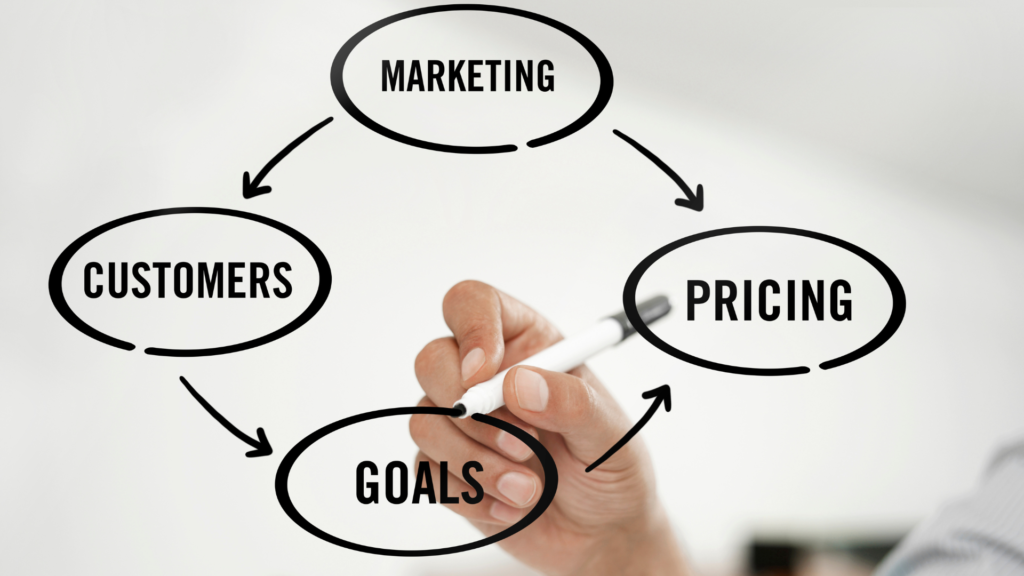10 Smart Types of Pricing Strategies to Boost Your Sales
Looking for the types of pricing strategies to boost your sales? This article covers key methods like penetration, competitive, and value-based pricing, and outlines their benefits and challenges.
Key Takeaways
- Developing an effective pricing strategy requires a comprehensive understanding of market demand, customer behavior, and competition.
- Strategies like penetration pricing and price skimming effectively target different consumer segments, from early adopters to price-sensitive customers.
- Utilizing psychological and dynamic pricing techniques can enhance sales and customer satisfaction, but businesses must carefully manage perceptions to maintain trust.
Understanding Pricing Strategies

A pricing strategy is a method businesses use to set the prices for their products or services, taking into account market analysis and customer demand. Effective pricing strategies are crucial because they influence a company’s ability to generate profit and reflect customer willingness to pay. Without a solid pricing strategy, businesses may struggle to stay competitive or meet their financial goals.
Creating a pricing strategy requires understanding market demand, customer behavior, competition, and business goals. This involves regular monitoring and adjustments to remain competitive and respond to market fluctuations. For instance, a surge in demand might prompt a temporary price increase, while increased competition might necessitate a price reduction.
A well-structured framework outlines business objectives, market analysis, cost evaluation, and customer value assessment, guiding businesses in setting prices that align with their goals. This comprehensive approach ensures that prices are not set arbitrarily but are based on a thorough understanding of various influencing factors.
Penetration Pricing Strategy
Penetration pricing involves entering the market with a very low price to attract customers. This strategy is particularly effective for new businesses aiming to quickly gain market share by offering products at a price point that is hard to resist. For example, a tech startup might launch its innovative software at a fraction of the usual cost to attract early adopters.
One of the primary benefits of penetration pricing is the ability to quickly boost initial sales and achieve a high turnover of inventory due to increased sales volume. This can be particularly advantageous in gaining a foothold in a competitive market. However, while it effectively attracts price-sensitive customers, it may not be sustainable in the long term.
After the initial phase, businesses often shift to higher prices to maintain profitability. This transition must be managed carefully to avoid losing the customers initially attracted by the low prices. Turning new buyers into loyal customers can help mitigate the risk of customer churn.
Price Skimming Strategy
Price skimming involves launching a product at a high price to maximize revenue from early adopters before gradually reducing the price to attract more cost-sensitive consumers. This strategy is commonly used for innovative products or technologies where early buyers are willing to pay a premium to be among the first to own the latest offering.
The primary benefit of price skimming is the ability to recover initial investment quickly by capitalizing on the willingness of early adopters to pay more. A new high-tech gadget might be priced high at launch, targeting tech enthusiasts who value being the first to experience new features.
Timing is crucial with price skimming. Delaying price reductions can lead customers to seek cheaper alternatives, while reducing prices too early can frustrate loyal customers. Additionally, once the initial prices increase, there is a risk that customers may revert to competitors. A well-timed strategy is key for maintaining customer satisfaction and maximizing profits.
Competitive Pricing Strategy
Competitive pricing, also known as competition-based pricing, involves setting prices based on competitors’ rates to remain competitive in the market. This strategy requires businesses to continuously analyze competitor offerings and pricing strategies to ensure their prices align effectively. This is particularly useful in markets with many players offering similar products or services.
Competitive pricing can help businesses stay relevant but can also trigger price wars, where companies continually lower prices to keep customers. This can lead to lower profit margins as businesses might have to sacrifice some of their desired profit margin to stay competitive. For example, in the retail industry, stores frequently adjust prices in response to competitors’ pricing to maintain their market share.
Understanding competitors’ prices and the reasons behind them helps businesses to determine their own pricing strategy effectively. Leveraging e-commerce tools and market analysis can aid in comparing prices and developing a competitive pricing strategy that not only attracts customers but also maintains profitability. Setting prices slightly below the market average can help maintain market share amidst competition.
Cost-Plus Pricing Strategy
Cost-plus pricing involves setting prices based on production costs plus a fixed percentage markup. This straightforward approach, often referred to as markup pricing, adds a fixed markup to the cost of production to determine the selling price. For example, a retailer might add a 20% markup to the cost of goods sold to achieve the desired profit margin.
One of the significant advantages of cost-plus pricing is its simplicity, making it easy for businesses to implement. Profits are more predictable with a fixed percentage markup, offering a clear and consistent pricing model. This method is particularly beneficial for businesses with stable costs and limited product variations, such as supermarkets and department stores.
A drawback of cost-plus pricing is that it does not consider external factors like competitors’ pricing or market demand. For instance, a pizza shop might set prices to achieve a 20% profit margin on ingredient and labor costs, but this approach might not be competitive if nearby restaurants offer similar pizzas at lower prices.
Value-Based Pricing Strategy
Value-based pricing sets prices based on the perceived value of a product or service rather than its production costs. This pricing method focuses on what customers believe the product is worth and are willing to pay. It is particularly effective for luxury products where brand perception significantly influences purchasing decisions.
Identifying the value of a product or service is crucial for crafting a suitable pricing strategy. For instance, a luxury watch brand may price its watches based on the perceived prestige and exclusivity associated with the brand, rather than the cost of materials and production. This approach adapts to various contexts, including both luxury goods and essential products.
To successfully implement value-based pricing, companies must invest in marketing, research, and public relations to effectively communicate the perceived value to customers. This involves understanding consumer perception of value and aligning the pricing strategy accordingly. Brands with distinctive features and strong identities are more likely to succeed using this approach.
Dynamic Pricing Strategy
Dynamic pricing is a strategy that adjusts prices based on current market demand, allowing businesses to respond to fluctuations in real-time. This approach is commonly used in industries such as hospitality, airlines, e-commerce, and event venues where demand can vary significantly. For example, a boutique hotel might raise its rates during a popular festival to capitalize on increased demand, while an online retailer might lower prices during off-peak hours to attract more customers.
Dynamic pricing can increase overall revenues by optimizing prices when demand is high. This adaptability can significantly boost profitability by ensuring that prices reflect current market conditions. Additionally, dynamic pricing can enhance inventory management by aligning prices with stock levels, helping businesses avoid overstocking or stockouts.
However, implementing dynamic pricing requires careful monitoring of market conditions and the ability to quickly adjust prices in response to changes. While it can be highly profitable, the strategy demands investment in technology and expertise to manage effectively. Businesses must also ensure that price adjustments are transparent and perceived as fair to maintain customer trust and satisfaction. When executed well, dynamic pricing can provide a competitive edge and optimize revenue by maximizing the value extracted from each sale.
Bundle Pricing Strategy
Bundle pricing involves selling two or more products or services together for one price. There are two main types of bundle pricing: pure bundling, where products are sold only as a bundle, and mixed bundling, where products can be purchased individually or as a bundle. For example, a video game store might offer a bundle that includes a console, an extra controller, and a popular game at a discounted rate.
One of the benefits of bundle pricing is that it encourages customers to discover new products and may lead to repeat purchases. Additionally, this strategy can enhance inventory management by helping to move less popular items when bundled with best-sellers.
However, bundle pricing has its drawbacks. Bundled products are bought less often individually, which can lead to product cannibalization where customers prefer the cheaper bundle over individual item purchases. Businesses must carefully consider which products to bundle to avoid devaluing their offerings.
Psychological Pricing Strategy
Psychological pricing refers to strategies that alter price, product placement, or packaging to influence consumer perception. Common tactics include pricing items at $9.99 instead of $10 to make them appear less expensive. This approach aims to create the illusion of value, encouraging consumers to feel satisfied with their purchases.
One of the pros of psychological pricing is that it can increase sales by adjusting sales tactics without sacrificing profits. For example, a gourmet hamburger priced at $12.95 instead of $13 can make the product seem more affordable while still maintaining a high profit margin.
However, psychological pricing can be perceived as tricky, potentially harming a business’s reputation if customers feel manipulated. It’s essential to balance the strategy to avoid this perception while leveraging its benefits to influence consumer behavior favorably.
Economy Pricing Strategy
Economy pricing focuses on achieving profit primarily through high sales volumes. This strategy works well for everyday products that consumers buy frequently, such as generic goods and low-cost airline tickets. Companies like Walmart and Costco typically employ economy pricing as one of the common pricing strategies to attract price-sensitive customers.
One of the primary benefits of economy pricing is its ability to thrive during economic downturns, as consumers tend to prioritize savings over brand loyalty. By offering a lower price, businesses can attract a larger customer base, increasing overall sales despite slimmer profit margins per unit.
However, a downside of the economy pricing strategy is that it can create the perception of low-value products among consumers. Maintaining low production costs relative to competitors is crucial for sustaining this strategy without compromising the quality that can drive customers away.
Freemium Pricing Strategy
Freemium pricing offers basic products or services for free while encouraging users to upgrade to a paid version for advanced features. Software businesses often utilize this strategy. Membership-based organizations also frequently apply it. For instance, a cloud storage company might offer limited free storage but charge for additional space and features.
One of the benefits of freemium pricing is that it helps build trust and educates potential customers about the product. Users get to experience the basic functionalities without any financial commitment, which can lead to higher conversion rates for paid plans once they see the value in the upgrade.
However, a drawback of freemium pricing is that it does not generate immediate revenue from every customer. Businesses must carefully balance the free and premium offerings to ensure that a significant portion of users are tempted to upgrade, thus sustaining the business model.
Loss-Leader Pricing Strategy
Loss-leader pricing attracts customers with heavily discounted items to encourage additional full-price purchases. A classic example is a supermarket offering bread at a very low price on Fridays to attract shoppers. The goal is to get customers into the store, where they are likely to purchase other items at regular prices.
One of the benefits of loss-leader pricing is that it can increase store traffic and expose customers to a broader range of products. This strategy works well in grocery stores and retail environments where impulse purchases are common.
However, some customers may only purchase the loss leader product, affecting overall profit margins. Businesses need to ensure that the loss leader items are strategically chosen to maximize the likelihood of additional purchases.
How to Choose the Right Pricing Strategy

Choosing the right pricing strategy involves aligning your pricing with your business goals, market conditions, and customer expectations. The first step is to determine your business objectives, whether it’s maximizing profits, gaining market share, or positioning your brand as the premium pricing strategy for a best pricing strategy offering.
Gathering customer feedback through surveys can provide valuable insights into what your customers are willing to pay. Conducting pricing experiments can also reveal how different price points affect consumer interest and sales. Analyzing how previous price changes impacted customer purchasing behavior can help refine your approach.
Remaining flexible and prepared to adjust prices if sales are slow or market conditions change is crucial. Establishing a price range ensures you do not lose profitability or alienate customers, setting both minimum and maximum prices appropriately.
Benefits of Effective Pricing Strategies
Effective pricing strategies help align business objectives with market demand, ultimately maximizing sales and profitability. A well-calibrated pricing strategy can contribute to successful product launches, ensuring that products meet market expectations and consumer needs.
A major benefit is attracting buyers and differentiating offerings from competitors, enhancing market penetration. For example, effective bundle pricing can attract customers seeking value, often leading them to spend more than they initially intended.
Psychological pricing fosters customer loyalty by creating positive feelings associated with perceived bargains, enhancing the customer experience. The successful conversion of free users to paid plans in a freemium model relies on attractive and valuable premium pricing features, further enhancing customer satisfaction.
Summary
Pricing strategies are a powerful tool in any business’s arsenal. By understanding and implementing the right pricing strategy, businesses can effectively attract and retain customers, maximize profits, and stay competitive in their markets. Whether it’s penetration pricing to quickly gain market share or psychological pricing to influence consumer perception, each strategy has its unique advantages and challenges.
In conclusion, the key to successful pricing lies in thorough market analysis, understanding customer behavior, and aligning pricing with business goals. By leveraging these strategies, businesses can enhance their market position, drive sales, and ultimately achieve long-term success. Remember, the right price can make all the difference!

Client Support
Have questions about your current services or need assistance? Contact our dedicated support team for personalized assistance tailored to your needs.

Discover Our Services
Interested in learning more about our services and how we can help your business? Schedule a consultation with one of our experts today.



